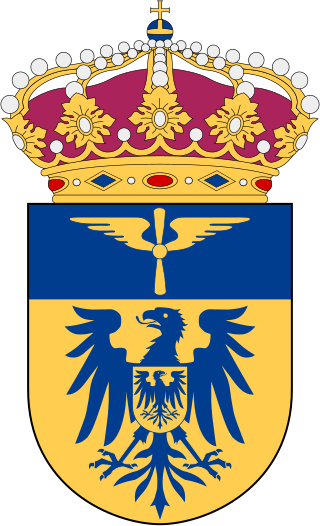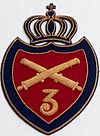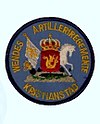
The Norrbotten Armoured Battalion, designation Pbat/I 19 or P 5, is a Swedish Army armoured battalion, one of the few new formations raised in the 20th century. It is still in active service, and is currently garrisoned in Boden, Norrbotten as part of Norrbotten Regiment.

The Västmanland Regiment, designations I 18 and Fo 48, was a Swedish Army infantry regiment that traced its origins back to the 16th century. It was disbanded for the first time in 1927 but later reraised and disbanded again in 1997. The regiment's soldiers were originally recruited from the province of Västmanland, and it was later garrisoned there.

The Life Grenadier Regiment, designations I 4 and I 4/Fo 41, was a Swedish Army infantry regiment that traced its origins back to the 16th century. It was disbanded in 1997. The regiment's soldiers were originally recruited from the provinces of Östergötland, and it was later garrisoned there.

The Värmland Regiment, designations I 22, I 2 and I 2/Fo 52, was a Swedish Army infantry regiment that traces its origins back to the 16th century. The regiment's soldiers were originally recruited from the province of Värmland, where the unit was later garrisoned. The unit was disbanded as a result of the disarmament policies set forward in the Defence Act of 2000.

The Norrland Artillery Regiment, designation A 4, was a Swedish Army artillery regiment that traced its origins back to the 19th century. The regiment's soldiers were originally recruited from the provinces of Norrland. The regiment was disbanded in 1997. From 1998 to 2000, the Boden Artillery Regiment was known by this name.

The Göta Signal Corps, designations S 1 Sk and S 2, was a Swedish Army signal unit, one of the few new formations raised in the 20th century. It was disbanded in 1997. The unit was garrisoned in Västergötland.

The Norrland Signal Battalion, designated Signbat/I 19, originally Norrland Signal Corps, designated S 3, was a Swedish Army signal unit, one of the few new formations raised in the 20th century. It was disbanded in 2005. The unit was garrisoned in Norrbotten.

The Svea Artillery Regiment, designation A 1, was a Swedish Army artillery regiment that traced its origins back to the 17th century. It was disbanded in 1997. The regiment's soldiers were originally recruited from Svealand, and it was also garrisoned there.

The Norrland Engineer Battalion, designation Ingbat/I 19, originally Boden Engineer Regiment, designation Ing 3, was a Swedish Army engineer unit, one of the few new formations raised in the 20th century. It was disbanded in 2005. The unit was garrisoned in Boden, Sweden.

Swedish Air Force Flying School, also F 5 Ljungbyhed, or simply F 5, is a former Swedish Air Force training wing with the main base located in Ljungbyhed in southern Sweden.

The Gotland Artillery Regiment was a Swedish Army artillery regiment that was in active service between 1811 and 2000. The regiment was based in Visby as part of the Gotland Garrison.

The 3rd Naval Warfare Flotilla of the Swedish Fleet was founded in 2005 when the former minelayer and surface flotillas joined together. The flotilla home base is in Karlskrona, Blekinge and is a part of the Karlskrona naval base. The flotilla mostly deploy ships in international missions today.

The Bergslagen Artillery Regiment, designation A 9, is a Swedish Army artillery unit which has operated in various forms from 1943 to 2000 and again from 4 December 2022 after the Swedish government decided to re-form the regiment in Kristinehamn as Bergslagen Artillery Regiment with full operational capability reached by 2025.

The Southern Army Division, was a division of the Swedish Army that operated in various forms from 1941 until 2000. Its staff was located in Kristianstad Garrison in Kristianstad. The unit was disbanded as a result of the disarmament policies set forward in the Defence Act of 2000.
Karlsborg Artillery Regiment, designation A 9, was a Swedish Army artillery unit which operated between 1920 and 1937. The unit was based in Karlsborg Garrison in Karlsborg, Sweden.
Uppland Artillery Regiment, designation A 5, was a Swedish Army artillery unit which operated between 1894 and 1927. The unit was based in Uppsala Garrison in Uppsala, Sweden.

Boden Artillery Regiment is an artillery unit within the Swedish Army that operated in various forms from 1919 to 2004 and again from 2022. It is based in Boden Garrison in Boden.

The Småland Artillery Regiment, designation A 6, was a Swedish Army artillery regiment raised in 1895. It was disbanded in 1985. The regiment was based in Jönköping.

The Scanian Dragoon Regiment, designated P 2 and P 2/Fo 14, was an armored regiment of the Swedish Army with its roots in the 17th century. The unit was first based in Helsingborg and later in Hässleholm.

The Naval Base is a naval unit within the Swedish Navy that has operated in various forms since 1928. The unit is mainly based within Karlskrona naval base in Karlskrona and but operations are also conducted at Berga Naval Base and Muskö naval base outside Stockholm and in Gothenburg.























